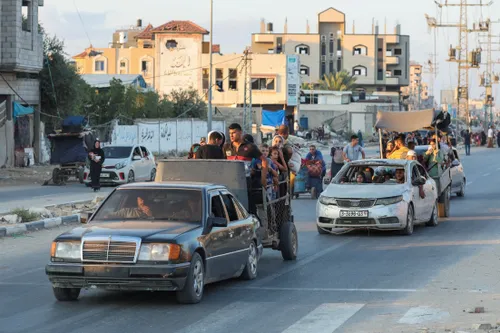The escalation of tensions in the Middle East is a multifaceted issue with profound implications for regional stability and global geopolitics. This essay explores the historical context of Middle Eastern conflicts, the factors contributing to current tensions, the key players involved, and the potential consequences of the ongoing crises. By understanding these elements, we can better grasp the complexity of the situation and its impact on international relations.
Table of Contents
Historical Context
The Middle East has long been a region marked by geopolitical struggles, rooted in its strategic location and rich natural resources, particularly oil. The historical legacy of colonialism, the creation of national boundaries without regard for ethnic and sectarian realities, and the Cold War rivalry between major powers have all contributed to the region’s volatile dynamics.
The aftermath of World War I saw the collapse of the Ottoman Empire and the imposition of artificial borders by European powers, leading to the establishment of new nation-states. The creation of Israel in 1948 and subsequent Arab-Israeli conflicts further intensified regional tensions. The Iranian Revolution of 1979, which led to the establishment of the Islamic Republic of Iran, introduced a new axis of conflict, particularly between Shia and Sunni factions and the West.
Current Factors Contributing to Tensions
Several factors are contributing to the current escalation of tensions in the Middle East:
- Political Instability: Many Middle Eastern countries are grappling with political instability, often exacerbated by authoritarian regimes, corruption, and lack of democratic processes. The Arab Spring, which began in 2010, led to a series of uprisings and conflicts, including the Syrian Civil War, which continues to be a major source of regional instability.
- Religious and Sectarian Divisions: The Middle East is home to diverse religious and sectarian communities. Tensions between Sunni and Shia Muslims, particularly involving Iran (a Shia-majority country) and Sunni-majority states such as Saudi Arabia, have fueled proxy wars and conflicts across the region.
- Geopolitical Rivalries: Major powers, including the United States, Russia, and China, have strategic interests in the Middle East. Their involvement often exacerbates local conflicts. For instance, the U.S. has historically been allied with Saudi Arabia and other Sunni-majority states, while Russia has strengthened ties with Iran and the Assad regime in Syria.
- Terrorism and Extremism: The rise of extremist groups, such as ISIS, has introduced new dimensions of violence and instability. These groups often exploit existing grievances and conflicts to further their agendas, leading to widespread suffering and displacement.
- Economic Challenges: Economic hardships, including high unemployment rates, inflation, and lack of economic opportunities, contribute to social unrest. The dependence on oil revenues, combined with fluctuating oil prices, has also impacted the economies of several Middle Eastern countries.
Key Players and Their Interests
Understanding the roles of key players is crucial to comprehending the current tensions:
- Iran: Iran’s regional ambitions, driven by its desire to expand Shia influence and counterbalance Sunni-majority states, have led to its involvement in various conflicts. Its support for groups like Hezbollah in Lebanon and its involvement in the Syrian Civil War are key examples of its regional strategy.
- Saudi Arabia: As a leading Sunni-majority power, Saudi Arabia has been engaged in a rivalry with Iran. Its involvement in the Yemen conflict and its efforts to counter Iranian influence are central to its regional policy. Additionally, the kingdom’s relationship with the U.S. and its recent efforts to diversify its economy have influenced its foreign policy.
- Turkey: Turkey, under President Recep Tayyip Erdoğan, has pursued an assertive foreign policy, including military interventions in Syria and Iraq. Its role as a NATO member and its complex relationship with both the West and regional powers like Iran and Russia make it a significant player in Middle Eastern dynamics.
- Israel: Israel’s security concerns and its complex relationships with neighboring Arab states are critical to the region’s stability. The Israeli-Palestinian conflict remains a central issue, with ongoing disputes over territory, security, and mutual recognition.
- The United States: The U.S. has been deeply involved in Middle Eastern affairs, driven by interests in securing energy resources, combating terrorism, and influencing regional geopolitics. Recent shifts in U.S. foreign policy, including its stance on Iran and involvement in Syria, have impacted the regional balance.
Consequences of the Escalation
The ongoing tensions in the Middle East have far-reaching consequences:
- Humanitarian Impact: The conflicts and instability have led to severe humanitarian crises, including massive displacement of people, loss of life, and destruction of infrastructure. The Syrian Civil War, for instance, has caused a significant refugee crisis, impacting neighboring countries and Europe.
- Economic Repercussions: The region’s instability affects global oil markets and economic conditions. Disruptions in oil production and trade can lead to fluctuations in global energy prices, impacting economies worldwide.
- Regional Security: The proliferation of weapons and the rise of extremist groups pose security threats not only to the Middle East but also to global stability. The spread of terrorism and the potential for regional conflicts to escalate into broader wars are ongoing concerns.
- International Relations: The Middle East remains a focal point of international diplomacy and conflict. The involvement of major powers and their competing interests contribute to the complexity of the situation, often leading to shifting alliances and ongoing diplomatic efforts.
Conclusion
The escalation of tensions in the Middle East is a complex and multifaceted issue, deeply rooted in historical grievances, geopolitical rivalries, and religious sectarianism. The interplay of local conflicts and international interests creates a challenging environment for achieving stability and peace. Understanding the historical context, current factors, and key players involved provides valuable insights into the ongoing crises and their broader implications. As the situation continues to evolve, it remains imperative for the international community to seek diplomatic solutions and address the underlying issues contributing to the region’s instability.








